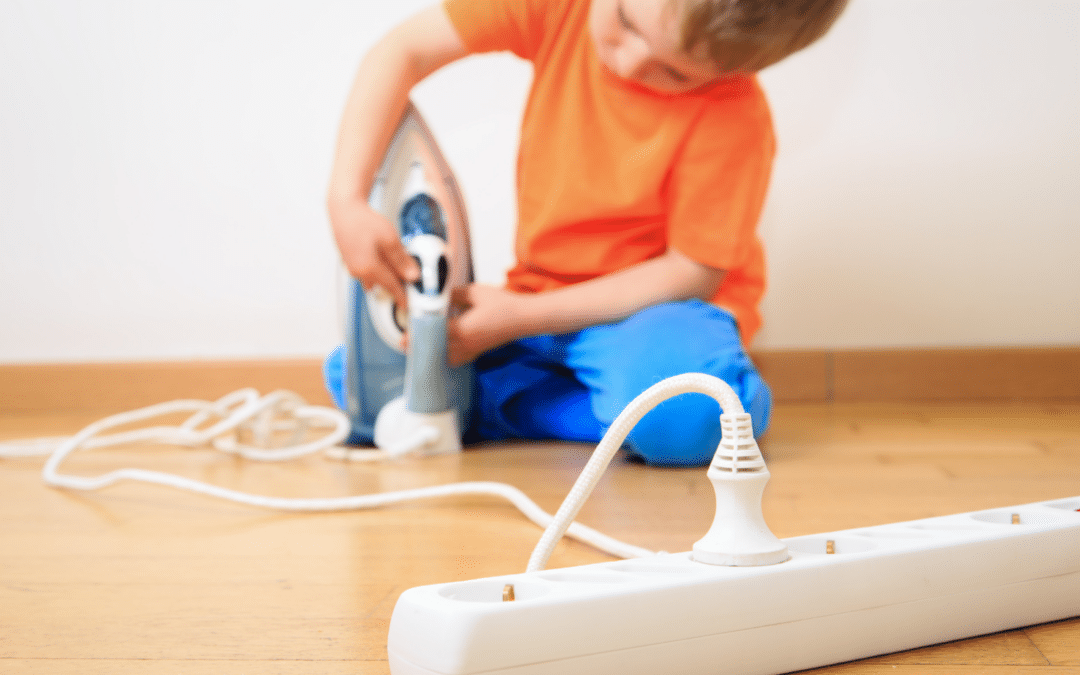When you have a baby in the house on the verge of crawling, it’s time to get busy with baby proofing. Young children have an uncanny attraction to things they should not touch, such as electrical outlets and cords. These items can be dangerous for them, but a few simple preventative measures can avoid disaster.
The first thing to do when baby proofing your home is to get down on your child’s eye level and determine what could be an electrical hazard.
Why to Baby-Proof Electrical Cords
We use long electrical cords in our homes to plug in lamps, appliances, computers and TVs. A crawling baby or young toddler can face danger around cords by:
- Tripping over them
- Pulling on cords and bringing down an attached appliance on top of them
- Yanking them out of electrical outlets
- Chewing on them
- Wrapping cords around their necks
- Playing with damaged cords possibly resulting in an electrical burn
4 Ways to Baby-Proof Electrical Cords
Here are some baby proofing safety measures for electrical cords that you can take to ensure that your child will be safe:
1. Cover exposed outlets
If possible, place furniture in front of exposed outlets as a barrier to your child’s curiosity. Do not, however, jam the furniture up against plugs. Keep a few inches of clearance between walls and furniture.
2. Cover cords or get a cord shortener
When it’s not possible to create barriers with furniture, you can use a cord cover or shortener. Covers help protect cords from being pulled, yanked or chewed on, and shorteners are fixed on the power outlet with space to store the excess of a long cord.
3. Tape down cords or cover them with carpets
Sometimes it is necessary to leave a cord lying on the floor, which can be a tripping hazard to kiddos learning to walk or an attractive item to pull on and touch. In this case, try to cover the cord with carpeting and tape it down to the floor and wall. You can also use duct cord covers to safely cover cords running along the floor.
4. Wrap cords together
While you can use tape or zip ties to wrap cords together, a cord or cable sleeve can look more stylish and are harder to remove. These are especially useful in your home office or behind the TV, where a lot of small cables are connected and exposed.
5 Ways to Secure Electrical Outlets
When you have secured the electrical cords, the next thing to review are your electrical outlets. Young children can get an electrical shock if they try to stick their fingers or any metal items into an outlet.
Here are some baby proofing safety measures for electrical outlets that you can take to ensure that your child’s safety:
1. Cover electrical outlets in reach of young children
There are several options to use here, but one of the most effective is to install slide outlet covers on vulnerable outlets. These require the cover to be slid to one side to plug in a cord. Unlike plug protectors that can be pulled out, kids tend not to be able to defeat a slide outlet cover.
2. Don’t plug cords into electrical outlets while children are watching.
It can lead to curiosity later as they try to figure out what you did and copy your actions themselves.
3. Keep their toys and other interesting objects away from outlets
This practice keeps their attention trained away from outlets. They’ll be less likely to spend their time near dangerous electrical outlets.
4. Do not leave appliances plugged in when not in use
This applies to items such as irons, hair dryers and vacuum cleaners. Again, leaving appliances plugged in can invite curiosity you don’t want, and it can leave the outlet unprotected if they yank out the cord.
5. Teach the safe use of electricity in your home
As kids get older, they can begin to understand what they are allowed to touch and what they must leave alone. Making a rule that they must ask you to plug things in and turn items on until they’re able to handle these tasks on their own is a smart approach to using electricity.
How Can We Help?
At Shockley Electric, we address important home safety issues such as power surges, faulty electrical wiring and potential fire hazards when we do electrical preventive maintenance in homes or commercial buildings.
We are licensed, trained, and skilled in safety-proofing your home, and we are committed to the safety and well-being of our customers.
If you are experiencing electrical problems in your home or aren’t sure if your home is protected from electrical hazards, schedule an in-home estimate or appointment with us today. Fill out our form or call us now for a free estimate!

